The Dell XPS 13 (9300) Review: Return of the King
by Brett Howse on July 16, 2020 10:00 AM ESTDisplay Analysis
Dell’s move back to 16:10 on their XPS laptop display panels is likely a welcome change for almost all prospective buyers. The PC industry aggressively moved to 16:9 with the rise of HD televisions, and while the 16:9 aspect ratio is still the default for most PC gaming and media consumption, most productivity tasks will enjoy the slightly taller display. Going to 16:10 instead of 3:2 like we have seen on Microsoft’s Surface lineup is also a nice compromise between productivity and consumption.
Dell is offering both 1920x1200 and 3840x2400 display offerings, which is in-line with what they’ve been doing with the XPS 13 lineup since at least 2015. For 2020 though, there is an optional touch digitizer on the lower resolution display, whereas in the past Dell only included touch with the higher-resolution panel. Both displays offer Dolby Vision processing and Eyesafe technology to reduce blue light transmission.
The 1920x1200 panel is a standard sRGB display, rated at 500 nits of brightness. Meanwhile the 3840x2400 panel has a much wider color gamut – offering 90% of the P3 color space – and is HDR 400 certified as well.
Dell sampled us the lower-resolution panel for review, but as with any Windows-based notebook with wider than sRGB gamut coverage, it is still a 'buyer beware' situation. Windows 10 does not offer the best color management system, and since almost all content and programs are designed around sRGB, if you opt for the wider-gamut display colors will be blown out unless you are using an application that specifically supports color management. For most people, the sRGB panel is the better option, not only because the 1920x1200 13.4-inch display still provides a reasonable 170 pixels-per-inch and much better battery life, but also because Windows still deals with wide-gamut and HDR poorly.
One area where Dell needs to be commended though is in their use of anti-glare coatings on their XPS displays. This has been one area that no PC manufacturer has really put much effort in, but Dell offers a 0.65% reflectivity rating on their coating, and it makes a big difference in day-to-day usage, especially in a bright room or outdoors.
To see how the XPS 13 display performs, it was tested using the Portrait Displays CalMAN software suite, using a custom workflow. Brightness and contrast were measured with the X-Rite i1Display Pro colorimeter, and color accuracy measurements were done with the X-Rite i1Pro2 spectrophotometer.
Brightness and Contrast
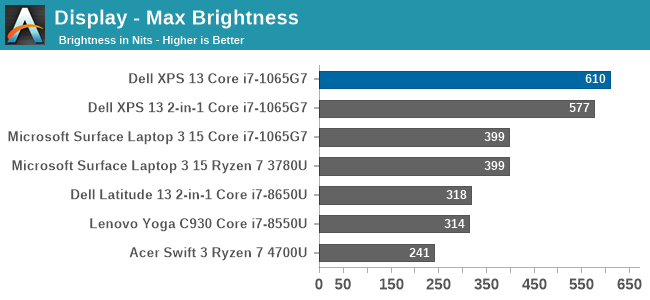
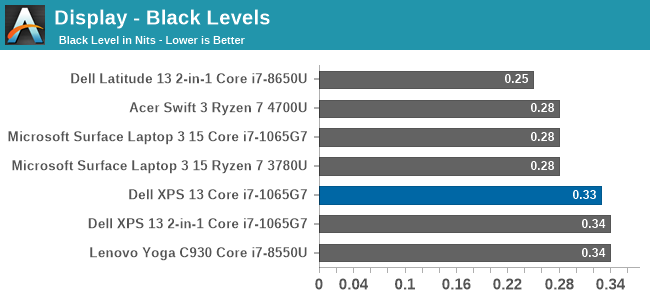
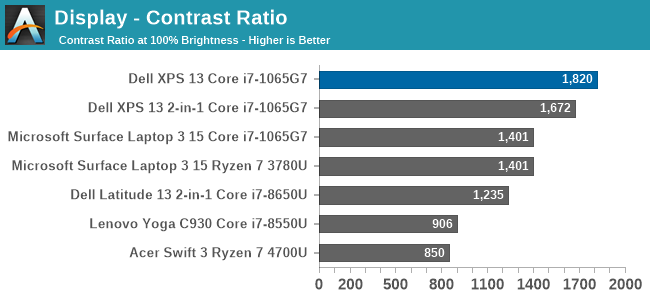
Despite the 500-nit rating, the XPS 13 managed to achieve a very impressive 610 nits of brightness. Coupled with the excellent anti-reflective coatings, the XPS 13 is easily one of the best notebooks for any bright location. The contrast ration of over 1800:1 was also top-notch.
Grayscale
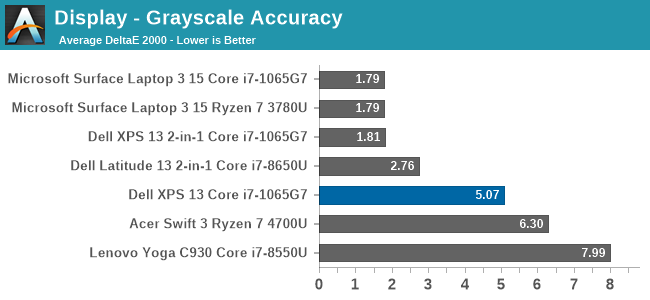
Despite the XPS 13 including an ICC profile, the review unit offered very poor grayscale performance, which was a disappointment after the XPS 13 2-in-1 we reviewed in November had such great results. Dell is likely using a batch-calibration process, rather than tuning each panel individually, which is a shame.
Gamut
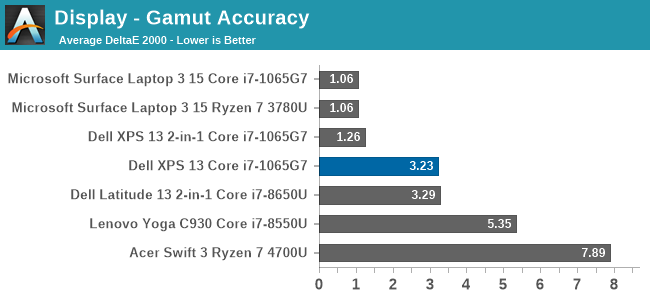
Grayscale aside, the color gamut results show a much better outcome, with really only Cyan having much in the way of color error. The display nicely hits sRGB primary and secondary color points, although does pull a bit to the green end, especially on Cyan.
Saturation
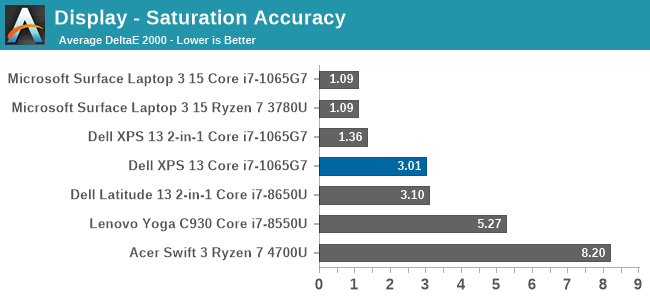
Gamut tests the sRGB color space at the 100% levels, but for the saturation test each primary and secondary color is tested in 4-bit steps from 0% to 100%. Really, other than the Cyan errors, the XPS 13’s color accuracy on these sweeps is quite good, just missing the 3.0 DeltaE threshold.
Gretag Macbeth

The Gretag Macbeth colorchecker tests many colors, not just the primary and secondary colors, and includes the important skin tones. To be considered accurate, all of the color tests on the DeltaE 2000 scale should be under the yellow line, and for the most part that is the case. The grayscales and the most impacted, which isn’t surprising with how inaccurate the grayscale was on this unit, with only a few colors over the 3.0 error level.
Colorchecker
The colorcheck swatch provides a relative look at how the display performs. The colors on the bottom half of the swatch are the targeted colors, and the top half is what the XPS 13 was able to provide. This is a relative result, because any error in your own display would impact this swatch.
For the most part, the color accuracy of the XPS 13 is very good, with mostly only grayscale errors. The bad news is that Dell did include an ICC profile to address this, but it had little to no impact on the grayscale. Meanwhile the good news is that since most of the errors are grayscale, if you owned your own calibration tools, the XPS 13 could be adjusted to give a reasonable result. But as a premium device, it would be nice to see Dell extend the calibration to every panel.


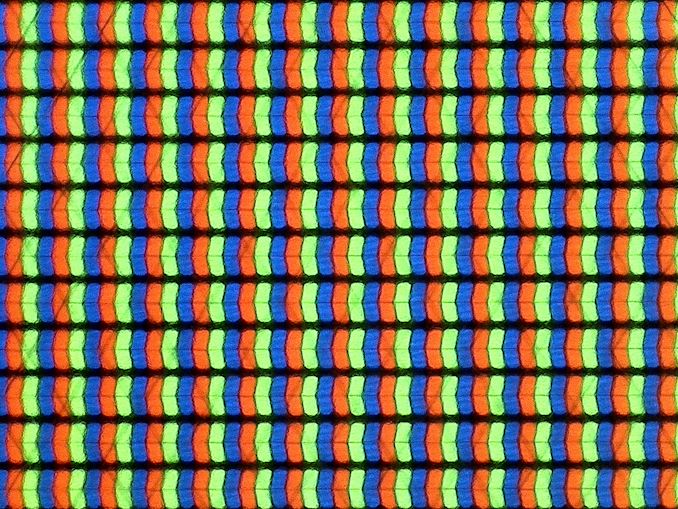













224 Comments
View All Comments
Deicidium369 - Friday, July 17, 2020 - link
Leaks from Lenovo show Tiger Lake Core i7-1165G7 (not even the top end part) obviously besting the ancient Vega (AMD's choice) and equaling the MX350 - and with only 4 cores only being outran by 17% - double the cores for 17% lead - and when you factor in the flagging GPU - what's the Renoir's advantage again?gescom - Friday, July 17, 2020 - link
Huh, let's wait for amd 5x00 cezanne, shall we?Deicidium369 - Friday, July 17, 2020 - link
Ice Lake is almost a year old. Comparing the latest AMD with an almost year old design should be a win for the newer part. the most appropriate comparison is 2020 vs 2020. That would be Tiger Lakegescom - Friday, July 17, 2020 - link
Tiger Lake Q4 2020 vsamd cezanne Q1 2021.
s.yu - Saturday, July 18, 2020 - link
You think it's the effort? So they haven't been putting all their effort into 10nm?...ok?
Spunjji - Friday, July 17, 2020 - link
As always for a Deicidium post about AMD, Lots Of Citations Needed."Problem with AMD is they are still trying to get Skylake levels of performance"
- They already matched that clock-for-clock with Raven Ridge (at lower clocks, hence lower overall performance), and they have now exceeded it with Renoir.
"Intel has well moved on from that architecture"
- Not really. I'd accept this if they had Sunny Cove or better across most of their range, but they absolutely do not - not even in notebooks, let alone the entire market.
Tiger Lake looks like it'll be a good release, when it arrives in quantity. Problem is that we're talking about today, not Jam Tomorrow.
Santoval - Friday, July 17, 2020 - link
It is still unclear if Tiger Lake will be a high volume release or a low volume release that will need to be released along perhaps Rocket Lake-U/Y, rehashing the way Ice Lake was released along with Comet Lake-U/Y. It should be higher volume than Ice Lake but maybe not high enough to fully supply the U/Y market on its own.Deicidium369 - Friday, July 17, 2020 - link
Well Ice Lake shipped in greater numbers than all of the Ryzen Mobile - so high volume is a relative term. Ice Lake was going to be low volume and relatively niche. Tiger Lake is high volume (not high volume like the Ice Lake SP Xeon) compared to Ice Lake U.I was surprised to see the 1065G7 in an Inspiron class machine at Dell - I had thought it was only the XPS class machines.
Spunjji - Monday, July 20, 2020 - link
@Deicidium - Of course it shipped in greater numbers than Ryzen Mobile! Intel are ~35X the size of AMD - you'd kind of hope they'd be shipping products in larger absolute numbers. I was talking about Sunny Cove as a proportion of Intel's product range, and I was pretty damn clear about that. It's telling that you flipped metrics under discussion to suit your argument."Ice Lake was going to be low volume and relatively niche" - says who? Why? To what end? You're pointing to the results of a sub-par product launch (by Intel's historically high standards) and claiming it was the plan all along. It's just like the AMD fanbois who used to laud the FX 9590's 5Ghz clock speed as if it was an achievement, rather than the best they could salvage from what they had.
You said Intel have "moved on" from Skylake. That's untrue and will remain the case until Rocket Lake, Ice Lake SP and Tiger Lake are out. At that point in time (and not before) Intel will be fully competitive in all areas on a technical level. I'm genuinely interested to see how Sunny Cove on 14nm looks - there's no reason to believe it won't be solidly competitive with AMD on performance, but power draw and die size might not be quite so flattering.
Santoval - Friday, July 17, 2020 - link
"Problem with AMD is they are still trying to get Skylake levels of performance, but Intel has well moved on from that architecture. Intel is solid as they come in ultralights/ultrabooks."That's a very bizarre statement for quite a few reasons :
1. AMD are not targeting Skylake performance levels. When they designed the original Zen they had in mind Cannon Lake - level performance (Intel semi-released a single semi-disabled Cannon Lake 2-core Core i3 in low volume and now they trying to pretend they never did) and when they designed Zen 2 (according to CTO Mark Papermaster) they were targeting it against Ice Lake - not knowing it would be limited to 4-core low power parts. AMD never had Skylake in mind because they never expected Intel would be stuck so many years with it.
2. Intel have not "well" moved on from Skylake at all. They *just* did, at the beginning of the year (still in low volume, hence the dual release with Comet Lake-U/Y, which was the bulk of the release), with low power 4-core mobile parts and they are *still* stuck with it in the form of Comet Lake. Until Comet Lake is replaced by Rocket Lake Intel are still stuck with Skylake, still fabbing and releasing CPUs with an μarch they have been using, reusing and re-reusing and re-re-reusing since 2015. In which parallel universe would that be regarded as "well moved on from that architecture"?